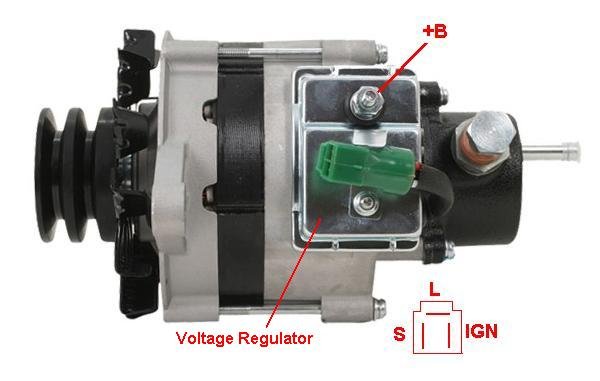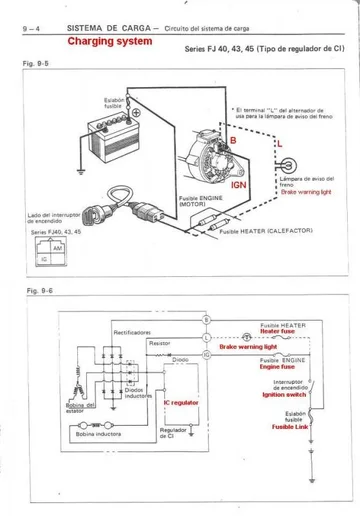bj40green
Tssss, tssss
This new thread is about Alternators with Internal Voltage Regulators and is the follow up on my other thread about External Voltage Regulators: -► Voltage Regulator (ext.) / How it works
If you’ve read my other thread you can skip this chapter and go to the 2nd posting.
If you came directly to this thread, read this chapter on the history of the VR for better understanding how it works.
In the beginning (60’s and 70’s) there was the 3 wire Voltage Regulator.
IGN: Voltage from the Ignition witch to the VR. This wire is used to activate the VR and at the same time to “sense” the voltage in the truck commanding the Alternator to FULL, HALF or NO charge via the F (Field) wire to the Alternator.
The 3rd wire is E (Earth) aka Ground. This E wire runs from the VR housing to the Alternator housing and acts as a parallel ground wire to the normal ground circuit. The purpose is to eliminate ground problems in the regular ground circuit.
From ’79 and later the 6 wire VR became available. The only difference with a 3 wire is that this VR is capable of turning an indicator light on or off. Aka “idiot light.” The main reason for this is that a light attracts more attention in case of a charge problem than the Ammeter.
The same 3 basic wires IGN, F and E are used but now there are 3 extra wires. N, L and B.
N (Null) comes from the Alternator and should be “high” when the alternator is spinning.
This N wire activates the Voltage relay, which activates the Regulating relay.
No voltage on the N wire means no “regulating” which results in a warning light that comes “on” on the dashboard. This is done by the L (Lamp) wire.
The warning light (Lamp) is hooked up on one side to 12V. The other side to the L wire on the VR. When the N output is “high”, the L output is also “high” which results in a light bulb that is hooked up on both sides to 12V. In other words; the lamp/light is “off”.
When the N output is Null (0V), the L output is also Null which results in a light bulb that is hooked up between 12V and Null (ground). In other words; the lamp/light is “on”.= NO CHARGE.
To get this circuit working it needs another voltage and that is added trough the B wire.
All good and well but it’s still a mechanical VR with all his little problems.
The disadvantages of a mechanical VR are; moving parts, contacts burning in, contacts stuck together and these VR’s created a noise/interference that the AM radios didn’t like. For that reason a capacitor was added to the VR.
Rudi
If you’ve read my other thread you can skip this chapter and go to the 2nd posting.
If you came directly to this thread, read this chapter on the history of the VR for better understanding how it works.
In the beginning (60’s and 70’s) there was the 3 wire Voltage Regulator.
IGN: Voltage from the Ignition witch to the VR. This wire is used to activate the VR and at the same time to “sense” the voltage in the truck commanding the Alternator to FULL, HALF or NO charge via the F (Field) wire to the Alternator.
The 3rd wire is E (Earth) aka Ground. This E wire runs from the VR housing to the Alternator housing and acts as a parallel ground wire to the normal ground circuit. The purpose is to eliminate ground problems in the regular ground circuit.
From ’79 and later the 6 wire VR became available. The only difference with a 3 wire is that this VR is capable of turning an indicator light on or off. Aka “idiot light.” The main reason for this is that a light attracts more attention in case of a charge problem than the Ammeter.
The same 3 basic wires IGN, F and E are used but now there are 3 extra wires. N, L and B.
N (Null) comes from the Alternator and should be “high” when the alternator is spinning.
This N wire activates the Voltage relay, which activates the Regulating relay.
No voltage on the N wire means no “regulating” which results in a warning light that comes “on” on the dashboard. This is done by the L (Lamp) wire.
The warning light (Lamp) is hooked up on one side to 12V. The other side to the L wire on the VR. When the N output is “high”, the L output is also “high” which results in a light bulb that is hooked up on both sides to 12V. In other words; the lamp/light is “off”.
When the N output is Null (0V), the L output is also Null which results in a light bulb that is hooked up between 12V and Null (ground). In other words; the lamp/light is “on”.= NO CHARGE.
To get this circuit working it needs another voltage and that is added trough the B wire.
All good and well but it’s still a mechanical VR with all his little problems.
The disadvantages of a mechanical VR are; moving parts, contacts burning in, contacts stuck together and these VR’s created a noise/interference that the AM radios didn’t like. For that reason a capacitor was added to the VR.
Rudi
Last edited:















 I like that. You've two different alternators.
I like that. You've two different alternators.